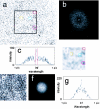Periodicity of cell attachment patterns during Escherichia coli biofilm development
- PMID: 12949116
- PMCID: PMC193763
- DOI: 10.1128/JB.185.18.5632-5638.2003
Periodicity of cell attachment patterns during Escherichia coli biofilm development
Abstract
The complex architecture of bacterial biofilms inevitably raises the question of their design. Microstructure of developing Escherichia coli biofilms was analyzed under static and laminar flow conditions. Cell attachment during early biofilm formation exhibited periodic density patterns that persisted during development. Several models for the origination of biofilm microstructure are considered, including an activator-inhibitor or Turing model.
Figures





References
-
- Baker, C. S., I. Morozov, K. Suzuki, T. Romeo, and P. Babitzke. 2002. CsrA regulates glycogen biosynthesis by preventing translation of glgC in Escherichia coli. Mol. Microbiol. 44:1599-1610. - PubMed
-
- Bassler, B. L. 2002. Small talk: cell-to-cell communication in bacteria. Cell 109:421-424. - PubMed
-
- Bees, M. A., and N. A. Hill. 1997. Wavelengths of bioconvection patterns. J. Exp. Biol. 200:1515-1526. - PubMed
-
- Boissonade, J. 1994. Chemical patterns—long-range inhibition. Nature 369:188-189.
Publication types
MeSH terms
Substances
LinkOut - more resources
Full Text Sources
Other Literature Sources

